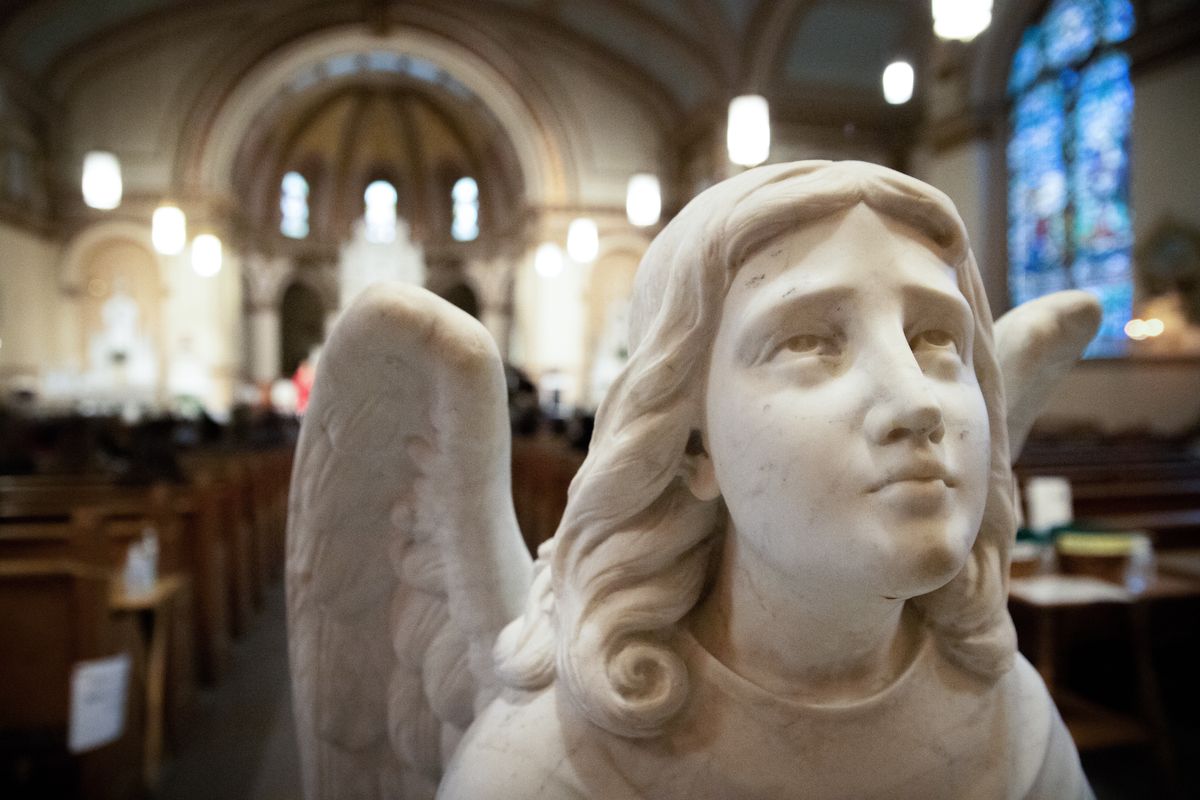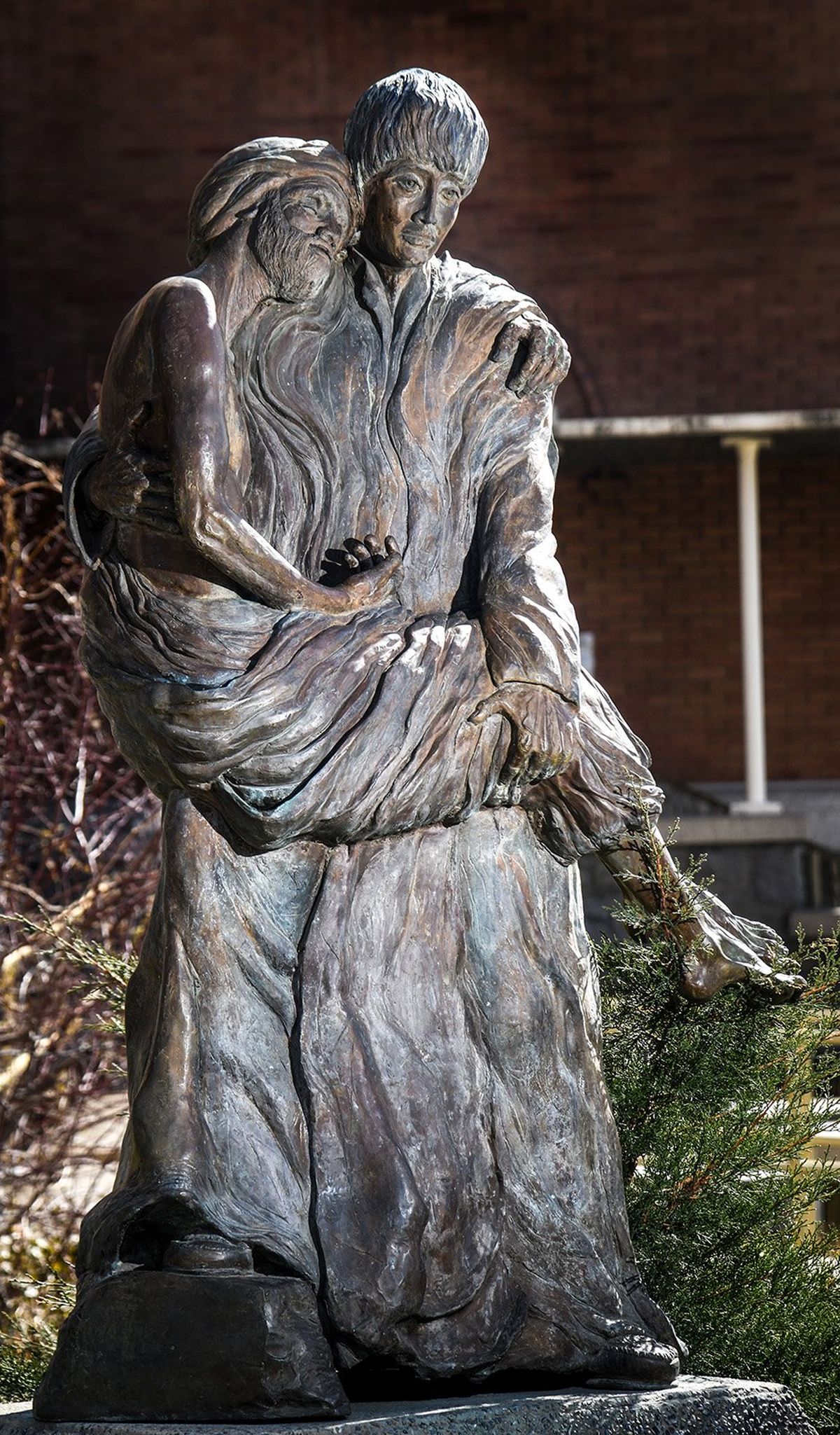‘It’s bittersweet’: Gonzaga’s conference move means leaving fellow faith-based schools behind
A basin of holy water is adorned with an angel sculpture, as seen during a service at St. Aloysius that coincided with Gonzaga’s Sweet Sixteen NCAA basketball game in 2021. (Libby Kamrowski/ THE SPOKESMAN-REVIEW)Buy a print of this photo
“Gonzaga to Change League” was the headline plastered across the sports section of The Spokane Daily Chronicle the day the university decided to join the West Coast Athletic Conference.
That headline, published almost 46 years ago to the day, could’ve been reused when news broke Tuesday that the university will be leaving its longtime home for athletics in 2026 to join the newly rebuilt Pac-12 Conference.
“We’re in an amazing position to be able to enter a great conference,” Gonzaga athletic director Chris Standiford said. “But we are moving towards a Pac-12, not away from the WCC.”
Amid dissolutions, mergers and expansions in collegiate athletic conferences, the West Coast Conference has weathered the repeated waves of realignment, managing to keep its coalition of private, faith-based schools intact.
Aside from the current iteration of the Big East, the WCC is one of few major or midmajor conferences home to multiple Catholic and Jesuit universities, and it holds the historic edge over its cross-coast counterpart by a few decades.
That’s part of the reason it was difficult to make the decision to leave, said Gonzaga University President Thayne McCulloh.
“We were friends, we partnered with other things besides the athletics,” McCulloh said. “So I think there’s a recognition that there’s some realities that we’re all wrestling with, and there also is some regret that we can’t figure out how to keep things together forever.”
McCulloh expects the Jesuit community to also have that understanding of the current landscape of collegiate athletics.
“I think that versus five years ago or so, there’s a lot more openness, and there’s probably a lot more understanding of the fact that universities who have athletic programs that are striving for real competitiveness and success have a difficult juggling act to try to manage,” McCulloh said.
Father Robert Lyons, the presiding officer of Gonzaga’s board of members, said he expects the relationships with fellow faith-based WCC members to stretch far beyond the university’s departure from the league. The board is made up of nine Jesuit members that represent the ownership of the university, the Society of Jesus within the Roman Catholic Church, and oversees matters specific to the religious mission of the university.
“Gonzaga’s relationship with other Jesuit and Catholic schools is multi-faceted; while we have enjoyed both cooperating and competing with universities that share common identities and values, athletics is only one of the ways in which we are, or have been, connected,” Lyons said in a written statement. “Many of us are and will remain connected through other associations and academic programs and are as committed to one another’s success as ever.”
The conference, which dropped “Athletic” from the name in 1989, has seen some changes in membership over the years, but has remained mostly intact and stable since its inception in 1952. Back then, it was known as the California Basketball Association, and included the University of San Francisco, Saint Mary’s College, Santa Clara University, San Jose State and the University of the Pacific.
As it stands today, seven full members of the conference are private universities affiliated with the Catholic Church, with Gonzaga, Santa Clara, San Francisco and Loyola Marymount University making up the Jesuit members. Pepperdine University and Pacific are affiliated with the Church of Christ and the United Methodist Church, respectively.
In interviews, top leaders at conference member institutions said they view athletics as an extension of their efforts to develop students holistically.
Santa Clara athletic director Heather Owen said “the Jesuit mission is to educate the whole person,” and she views athletics as working hand in hand with that mission.
“Within sports, particularly college sports, most coaches would say the same thing, maybe different words, but they’re saying the same thing,” Owen said. “They are there to educate the whole person, physically, mentally and emotionally, and their pathway to such is sport or competition.”
A focus on basketball by faith-based institutions has always been ingrained in the fabric of the WCC, although there are no bylaws requiring member schools to be private or faith-based, noted WCC Associate External Relations Commissioner Doug Drabik.
Owen thinks a commitment to a basketball-centric conference, the many similarities between the member schools and their regional proximity have played a large role in keeping the conference stable through the waves of realignment.
“There’s a commonality and synergy in terms of the academic missions and profiles of the institutions,” Owen said. “The faith-based nature, Jesuit-nature of the schools is something that ties them.”
Seattle University President Eduardo Peñalver agreed the similarities between the member schools have likely played a large role in the conference’s resilience.
“What I always say about athletic conferences is it’s kind of like a family,” Peñalver said. “It’s kind of like a marriage, right?”
Seattle University is set to join its fellow private, Catholic Jesuit institutions in the West Coast Conference next fall, bringing a more than 40-year absence from the league to a close.
Peñalver said the school is a bit of an outlier in its current home in the Western Athletic Conference, which is composed of mostly state-funded public schools in the Southeastern United States.
The university has for a while been considering returning to a conference of similar-sized schools, in the same geographic footprint, with like-minded values and missions.
Seattle University was a member of the conference from 1971 to 1980, before a local recession forced the administration to move athletics down to the smaller National Association of Intercollegiate Athletics level for more than two decades. The school spent most of the 2000s working its way from Division III back to Division I in the NCAA.
The WCC feels like a more natural fit in many regards, Peñalver said.
Conference partnerships often go beyond the athletic field, as schools work together on research and educational opportunities, programs aimed at helping their communities or spiritual missions, he added.
McCulloh shared a similar sentiment when reflecting on how valuable the WCC was in providing an avenue to meet with other university presidents to discuss challenges outside of athletics, like the COVID-19 pandemic. He expects those partnerships to continue beyond Gonzaga’s move in 2026.
“I enjoy, and will continue to enjoy, our opportunities to be able to meet one another on the field or the court or wherever it may be,” McCulloh said. “Because all of us care about the same things in great measure, and our students are at the forefront of that.”
Owen said she expects Gonzaga’s departure to impact the conference, given its national prominence, but that the move provides a “tremendous opportunity to figure out and chart the next course for Santa Clara.”
Owen started her position last month after spending 16 years with her alma mater Stanford University’s athletic department in a variety of capacities. The Moscow, Idaho, transplant has first-hand experience with the impacts of realignment, whether it was watching her hometown University of Idaho Vandals’ journey to the FCS level or watching Stanford’s debut in the Atlantic Coast Conference this fall.
“It’s hard to wrap your head around,” Owen said. “Stanford football played Clemson at Clemson in a conference game. Let’s just think about that for a minute.”
What’s sometimes lost in the realignment chaos is the effect it can have on the student athletes, who now have to travel great distances multiple times a season to play cross-country fellow conference members, Owen said.
“I think we have to acknowledge that,” Owen said. “Now that said, I would suspect most Division I student athletes, or heck, all student athletes, want to play in competitive contests against the best. That’s why they do what they do, right?”
Realignment isn’t the only challenge facing collegiate athletics right now.
Schools across the country, including the members of the WCC, will have to navigate the implications of the House v. NCAA settlement, which will likely require schools and conferences to compensate athletes for use of their name, image and likeness on television broadcasts.
There’s also the challenges of navigating the new name, image and likeness system, a number of lawsuits by athletes aiming to get back pay for their time spent in the NCAA before the era of NIL, and some are floating the idea of creating a 72-team super league solely for top football brands.
“Those are just more headwinds that the NCAA and its members need to try to navigate,” Owen said. I’m hopeful we can land that plane sooner rather than later, and come to an agreement that’s palatable, if you will, for both sides, and we can get back to why we all got in this business – which is to educate young people through sport and academics.”
As a president of a university about to make its own realignment move amid those challenges, Peñalver is focused on the benefits and opportunities to come.
“I think each school kind of has to find their own way forward,” Peñalver said. “It’s a challenging time in athletics.”
He said the WCC will provide competitive matches, an increased recruitment footprint for student athletes and prospective students, and more natural rivalries. Seattle’s teams won’t have to travel as far, and there’s also a lot of crossover between alumni of the member institutions in the various West Coast cities the schools are located in, which should make for exciting game-day environments, he said.
McCulloh made many of the same points regarding Gonzaga’s decision to join the Pac-12. The conference’s footprint is regional, competition will be fiercer, the athletic contests come with new academic partnerships, and the Zags will be able to bolster recruitment in the cities and states they’ll play in, he said.
“We’re really, really passionate about making sure that we strike a balance between opportunity and ensuring that our student athletes are able to access, equally, the academic experience that we promised them,” McCulloh said.
McCulloh, the first non-Jesuit president to hold the top position at Gonzaga, announced his retirement earlier this year. He’ll leave his post next July, a full year before the Bulldogs will start competition in their new conference.
McCulloh said he hopes his successor embraces the many opportunities that will come through the realignment, particularly with Gonzaga’s fellow new members of the Pac-12.
“At the end of the day, all of the opportunity exists because of relationships,” McCulloh said. “And there’s huge opportunity with some fabulous leaders and members of their respective communities that are excited.”

